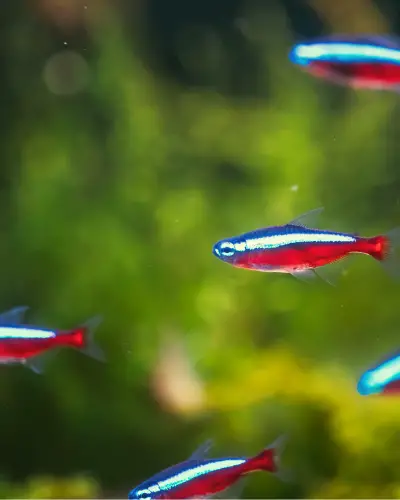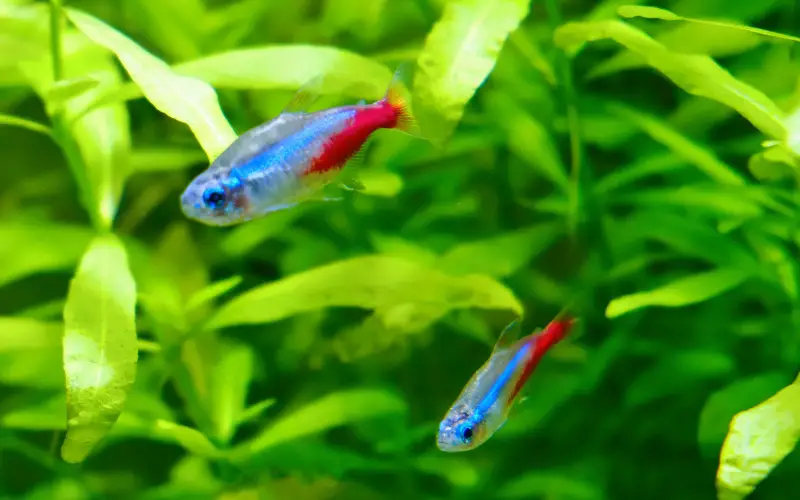Is Neon tetra schooling fish? Glowing tetras are one of the most popular aquarium fish species for aquarium enthusiasts due to their vibrant colors and peaceful demeanor. One of the most fascinating aspects of neon tetras is their schooling behavior, where they swim together synchronized.
For aquarium owners, understanding and appreciating this schooling behavior is essential for providing a suitable environment for these colorful fish to thrive.
In this neon fish care guide, we will explore the fascinating world of neon tetras schooling behavior and provide tips for aquarium owners to recreate a natural and stimulating environment for their fish.

From the benefits of schooling behavior to tips on tank size and tank mates, we will cover everything you need to know to ensure the happiness and well-being of your tetras.
So, whether you are a seasoned aquarium owner or a beginner looking to add these stunning fish to your community tank, read on to discover how to enhance your neon fish schooling behavior.
Table of Contents
ToggleAre Neon Tetras Schooling Fish?
Neon tetras paracheirodon innesi are indeed schooling fish, meaning they prefer to be kept in groups rather than alone. In their native habitat of the slow-moving streams and rivers of South America, Neons will form schools to protect themselves from predators and find food more efficiently.
When kept in a home aquarium, they will display their colorful blue and red colors most vividly in a group. It is recommended to keep a number of at least six Neons together to reduce stress and encourage their natural behavior.

Neon tetras are generally peaceful community fish who will get along well with other small, non-aggressive fish like Rasboras and catfish.
When you buy neon fish from a store, it’s essential to carefully acclimate them to their new aquarium water to minimize stress and avoid any deaths. Adding a dark substrate, some plants, and driftwood to the tank will enable Neons to relax and feel more at home.
Neon tetras are smaller and gentler, ideal for beginner and experienced aquarists. Offering a varied diet that includes baby brine shrimp and frozen and freeze-dried foods will help keep them healthy and thriving.
Understanding Neon Tetra Schooling Behavior in Aquarium
Neon tetras are well known for their stunning schooling behavior in aquariums. This mesmerizing movement isn’t just for show; it’s an anti-predator adaptation. In the wild, these small fish live in large schools in rivers and streams of the Amazon basin.
When threatened by a predator, the entire school acts as a single, confusing unit, making it difficult for the predator to focus on one particular fish.
Here are some critical aspects of neon tetras schooling behavior in a home aquarium:
- Neon Tetra School size: Ideally, a school of neon tetras should have at least 6-8 individuals, though some hobbyists recommend upwards of 10 or more. The fish will feel more secure with a larger school and exhibit tighter schooling behavior.
- Triggers for schooling: Neons tend to school more tightly when stressed or scared. Various factors, such as sudden movements outside the fish tank, introduction of new tank mates, or changes in water quality, can cause this.
- Benefits of schooling: Schooling provides several advantages, including Safety in numbers. As mentioned earlier, schooling makes it more difficult for predators to single out individual fish.
- Stress reduction: When swimming in a school, neon tetras feel more secure and less stressed.
- Improved foraging: Schools of fish can more efficiently locate food sources.
- Not always schooling: It’s important to note that tetras will only sometimes be schooling tightly. When comfortable and safe, they may swim in looser groups or explore different parts of the tank.
If you’re looking to encourage schooling behavior in your neons, here are a few tips:
- Provide a well-planted tank: Plants help neon fish feel more secure and provide hiding places.
- Keep the tank dimly lit. Neons are schooling fish found in the shady blackwater rivers of the Amazon. Too much bright light can stress them out.
- Avoid keeping them with large or aggressive fish. This will make the neon tetras feel constantly threatened, hindering their schooling behavior.
- Maintain weekly water change: Clean, stable water conditions are essential for the health and well-being of all fish, including neon tetras.
By following these tips, you can create a healthy and natural environment for your neon tetras and enjoy the beauty of their schooling behavior.
Commonly Asked Questions and Answers about Neon Tetras Schooling (FAQs)
Why are my neon tetras not schooling?
Glowing tetras may not school all the time, but that’s a good sign—they feel safe and relaxed in their environment. They tend to shoal loosely or school tightly only when stressed.
How Many Neon Tetras in a School?
The ideal school size for Neon Tetras is 6-10 individuals. This allows them to exhibit natural schooling behavior and reduces stress.
Can Neons and Paracheirodon axelrodi Cardinal Tetra School Together?
Will Cardinal and Neon Tetras school together? Yes, Neons and Cardinal Tetras often school together! They have similar sizes and schooling behaviors, creating a dazzling mixed display.
Why is one neon tetra not schooling?
A lone neon tetra may not be in school due to stress, illness, or simply being a new addition to the tank, but it is still acclimating.
Will black neon tetras school with neon tetras?
Yes, black neon tetras will school with Neons. Both species exhibit schooling behavior and can be kept together in the same aquarium, creating a visually stunning synchronized swimming display.
How many neon tetras should be kept together?
A minimum of 6 neon tetras should be kept together. Neon fish thrive in groups, and maintaining a school of at least 6 individuals ensures their social well-being and displays their natural schooling behavior in the aquarium.
Do neon tetras need to be in groups?
Yes, they are shoaling fish and need a group for comfort. Aim for at least six neon tetras in a well-planted tank, ideally 8-12.
Can red cherry shrimp live with tetras?
Yes, but with caution! Tetras may nibble on baby shrimp. Provide ample hiding spots, such as plants and caves, for the shrimplets to thrive.
Conclusion
In conclusion, keeping neon tetras as pets can be a rewarding and captivating experience. These vibrant little fish bring life and color to any aquarium, and their peaceful nature makes them perfect companions for both beginners and experienced fishkeepers alike. From stunning neon blue and red hues to playful and synchronized swimming patterns, neon tetras never fail to mesmerize onlookers.
One of the most fascinating aspects of glowing tetras is their schooling behavior. Watching a group of these fish move together in perfect harmony is a sight to behold. Their synchronized movements create a mesmerizing dance that adds a sense of tranquility to any aquarium.
Whether you’re a seasoned aquarist or just starting, introducing a group of neon tetras to your tank will bring joy and beauty to your aquatic world. So go ahead, dive into the world of Neon tetra schooling behavior, and witness the enchanting allure of these captivating fish firsthand.
You might also like
- Cardinal Tetra Vs Neon Tetra: Which One is (Better for You!)
- The Ideal Neon Tetra Fish Tank Size: A Comprehensive Guide
- How Many Neon Tetras in a 10 Gallon Tank: (Best Practices)
- Neon Tetras Life Expectancy: Avoid These 3 Deadly Mistakes!
- Glowing Tetra Tank Mates: 7 Stunning Tank Mates for Neon Tetras
- How Many Neon Tetras in A 5 Gallon Tank (Best Practices)




